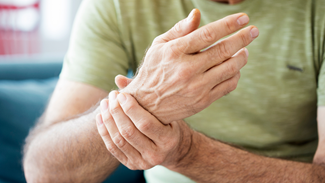It’s commonly believed that those old aches and pains are an inevitable part of growing older, and while you may not be able to eliminate arthritis, there’s a lot you can do to keep it from curtailing your activities.
Arthritis affects the joints, but it’s not one single disease. Over 100 different types of arthritis affect more than 50 million adults and 300,000 children.
What Is Arthritis?
Arthritis is an inflammation of the joints, such as the knees, back and fingers. You may feel pain and stiffness or notice swelling and decreased range of motion in the affected areas. Symptoms may come and go and vary in severity. Over time, the pain may get worse, even to the point of making it difficult to do daily activities such as walking. Arthritis also can cause permanent joint changes.
The most common type of arthritis is osteoarthritis. It is caused when the cartilage, which cushions the ends of bones, wears away, leaving bone to rub against bone. That creates pain and swelling.
Rheumatoid arthritis (RA) is a disease of the autoimmune system. The body mistakenly attacks the joints, causing the tissue inside the joints to thicken, creating swelling and pain. In addition to pain, you also may feel tired or lose your appetite due to the inflammation. If unaddressed, RA can damage the cartilage and bones, leading to joint deformity. RA most often affects the feet, wrists, elbows, knees and ankles, and you’ll usually feel the pain on both the left and right side. Because RA also can affect other systems in the body, including cardio and respiratory, it is particularly important to work with your doctor to control the disease.
Who Gets Arthritis?
While anyone can develop arthritis, it is more common in adults over 65 and in women. Other factors that can increase the risk of developing arthritis include:
-
Smoking particularly for those who have smoked 20+ years
-
A physically demanding occupation with repetitive movement
How to Diminish Pain from Arthritis
If you have painful joints, don’t just accept it as the price of growing older. Make a doctor’s appointment to determine if you have arthritis and if so, determine which type so you can receive the proper treatment. This is particularly important with RA.
Regardless of the type of arthritis, knowing how to treat pain levels and prevent the arthritis from worsening is critical. And the sooner you know, the better.
To address current symptoms, your doctor may suggest using analgesics (such as acetaminophen), NSAIDs (like ibuprofen) or menthol creams. Activity modification and immobilization also may be a part of your treatment recommendations. Other medications such as immunosuppressants may be considered in RA and other inflammatory arthritides.
Non-medicinal measures such as heating pads, ice packs, massage or acupuncture, quality sleep and physical therapy also may bring relief. Surgery that replaces a painful joint with an artificial one may be an option as well.

Lowering Risk and Pain of Arthritis
Even before you have symptoms of arthritis, you can take steps to decrease your risk of developing it. For those who already suffer from the disease, these lifestyle changes can help reduce your symptoms and decrease your chances of developing others.
-
Control your weight. Staying within a healthy weight range puts less stress on your joints.
-
Eat a diet rich in antioxidants, which are known to reduce inflammation.
-
Exercise to maintain the range of motion in your joints. Swimming is an excellent exercise because it does not put pressure on the joints.
-
Avoid injury. If you play a sport, use appropriate protective gear (i.e. bicycle helmet).
-
Use good posture when sitting and standing to protect your joints.
Arthritis may not go away, but by working with your physician, you can learn how to manage and minimize the disease, so you can live a more active, pain-free life.
Get a Free Guide to Prevent Sports Injuries
While exercise and sports-related activities often have a positive impact on our lives, they can also lead to serious injury. At the Orlando Health Orthopedic Institute, our multidisciplinary sports medicine team is committed to providing exceptional orthopedic care to help you return to your active, pain-free lifestyle.
Learn More










